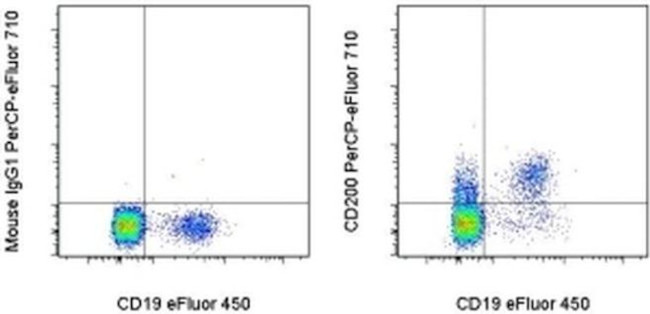Search Thermo Fisher Scientific
Invitrogen
CD200 Monoclonal Antibody (OX104), PerCP-eFluor™ 710, eBioscience™
FIGURE: 1 / 2
CD200 Antibody (46-9200-42) in Flow


Product Details
46-9200-42
Species Reactivity
Published species
Host/Isotype
Recommended Isotype Control
Class
Type
Clone
Conjugate
Excitation/Emission Max
Form
Concentration
Purification
Storage buffer
Contains
Storage conditions
Shipping conditions
RRID
Product Specific Information
Description: The monoclonal antibody OX104 recognizes human CD200 also known as OX2. CD200 is a member of the Ig superfamily with 2 Ig domains, a transmembrane and cytoplasmic domain. CD200 is expressed on resting and activated B cells, a subset of resting and activated T cells, keratinocytes, peripheral and central nerve cells, follicular dendritic cells and ovarian cells. The interaction with CD200R results in macrophage activation (IL-6 production), inhibition of mast cell degranulation along with reduced TNF alpha and IL-13 secretion and overall attenuation of the activation status of lymphocytes. A role has also been suggested in maternal tolerance as expression of CD200 is also present on the trophoblast.
Applications Reported: This OX104 antibody has been reported for use in flow cytometric analysis.
Applications Tested: This OX104 antibody has been pre-titrated and tested by flow cytometric analysis of normal human peripheral blood cells. This can be used at 5 µL (0.125 µg) per test. A test is defined as the amount (µg) of antibody that will stain a cell sample in a final volume of 100 µL. Cell number should be determined empirically but can range from 10^5 to 10^8 cells/test.
PerCP-eFluor® 710 emits at 710 nm and is excited with the blue laser (488 nm); it can be used in place of PerCP-Cyanine5.5. We recommend using a 710/50 bandpass filter, however, the 695/40 bandpass filter is an acceptable alternative. Please make sure that your instrument is capable of detecting this fluorochrome.
Fixation: Samples can be stored in IC Fixation Buffer (Product # 00-822-49) (100 µL cell sample + 100 µL IC Fixation Buffer) or 1-step Fix/Lyse Solution (Product # 00-5333-54) for up to 3 days in the dark at 4°C with minimal impact on brightness and FRET efficiency/compensation. Some generalizations regarding fluorophore performance after fixation can be made, but clone specific performance should be determined empirically.
Excitation: 488 nm; Emission: 710 nm; Laser: Blue Laser.
Filtration: 0.2 µm post-manufacturing filtered.
Target Information
CD200 is a type-1 membrane glycoprotein that contains two immunoglobulin domains, and belongs to the immunoglobulin superfamily. CD200 is a broadly distributed cell surface glycoprotein that interacts with a receptor on myeloid cells (CD200R) and is implicated in locally preventing macrophage activation. Distant, but recognizable, homologues of CD200 have been identified in many herpesviruses and poxviruses. Studies of the related genes in mouse and rat suggest that CD200 may regulate myeloid cell activity and delivers an inhibitory signal for the macrophage lineage in diverse tissues. Multiple alternatively spliced transcript variants that encode different isoforms of CD200 have been found. Diseases associated with CD200 dysfunction include Mantle Cell Lymphoma and Primary Hypertrophic Osteoarthropathy.
For Research Use Only. Not for use in diagnostic procedures. Not for resale without express authorization.
How to use the Panel Builder
Watch the video to learn how to use the Invitrogen Flow Cytometry Panel Builder to build your next flow cytometry panel in 5 easy steps.
Bioinformatics
Protein Aliases: antigen identified by monoclonal antibody MRC OX-2; CD200; CD200 antigen; OX-2 membrane glycoprotein
Gene Aliases: CD200; MOX1; MOX2; MRC; My033; OX-2
UniProt ID: (Human) P41217
Entrez Gene ID: (Human) 4345

Performance Guarantee
If an Invitrogen™ antibody doesn't perform as described on our website or datasheet,we'll replace the product at no cost to you, or provide you with a credit for a future purchase.*
Learn more
We're here to help
Get expert recommendations for common problems or connect directly with an on staff expert for technical assistance related to applications, equipment and general product use.
Contact tech support

